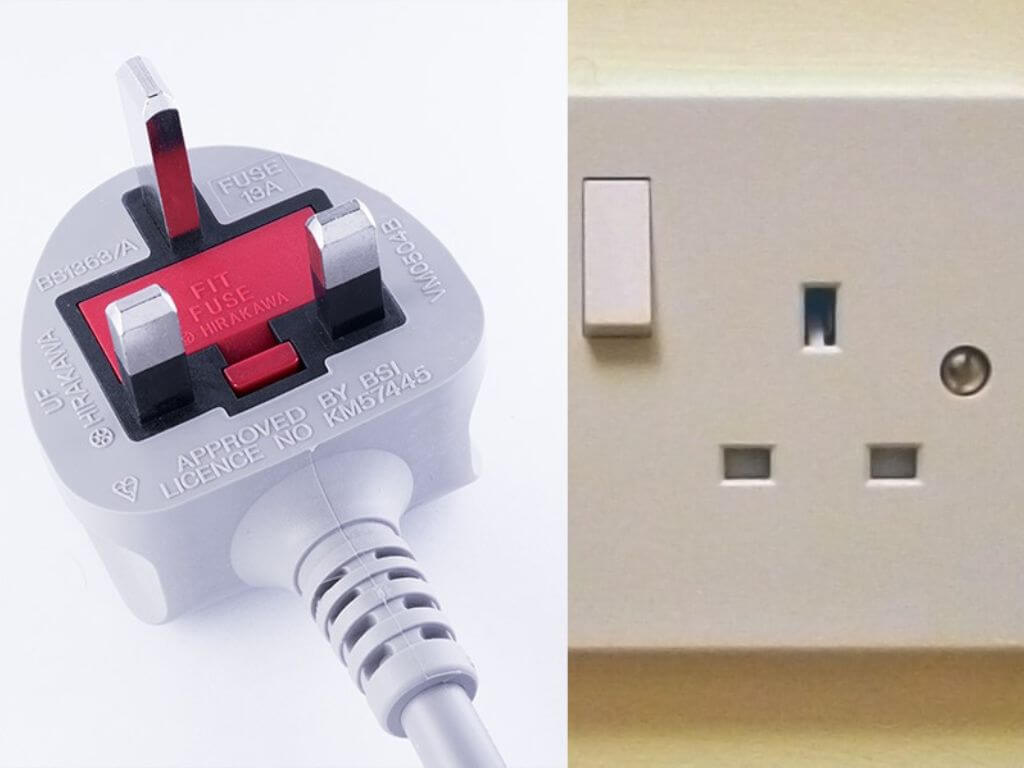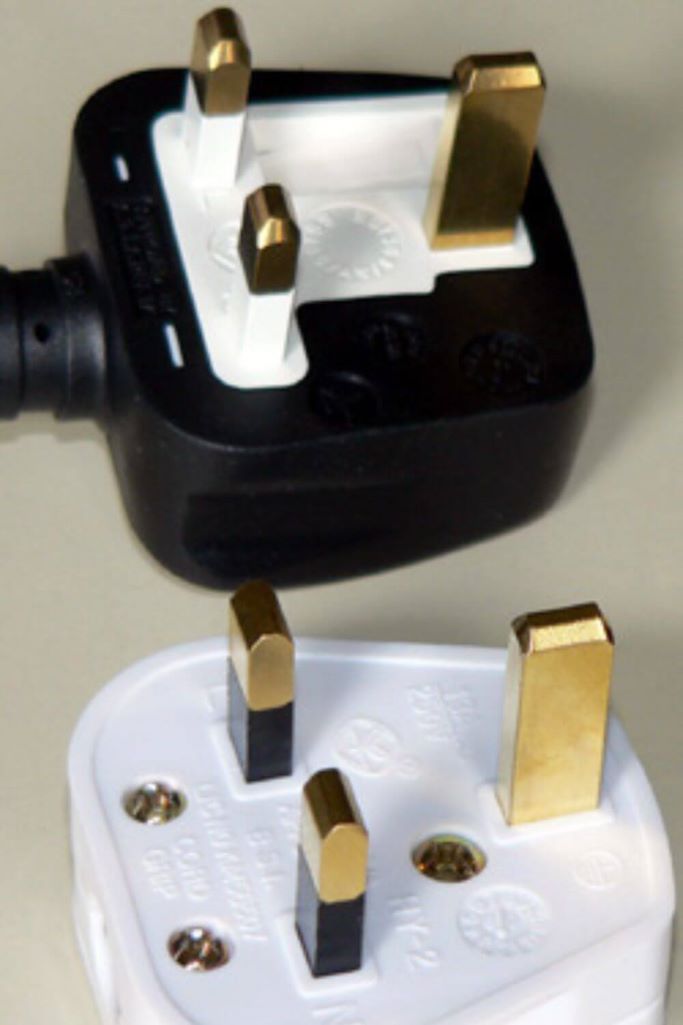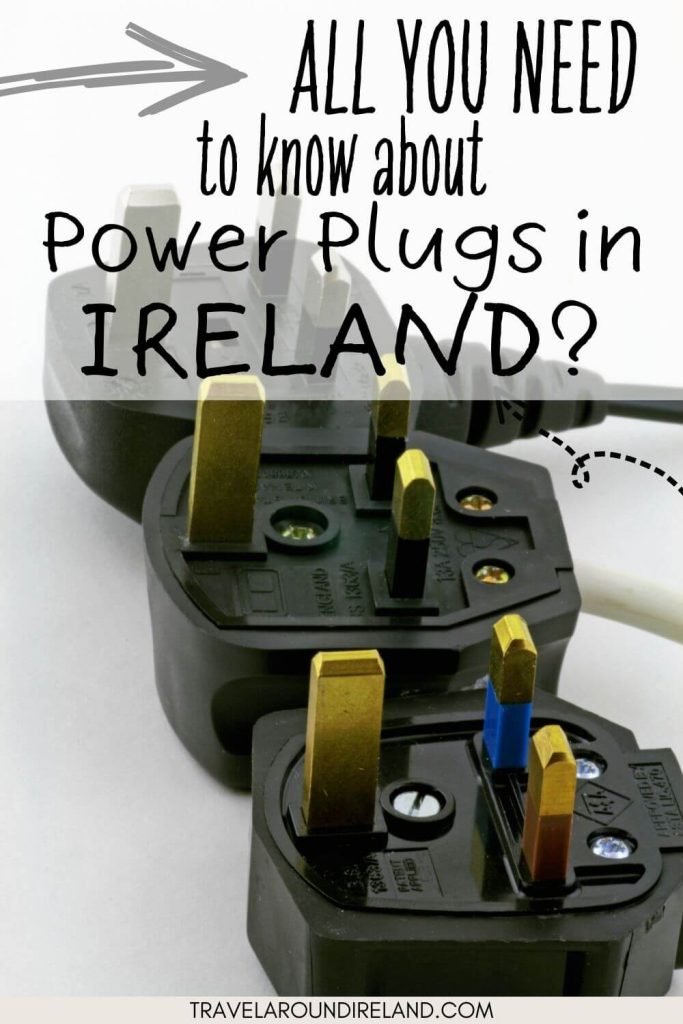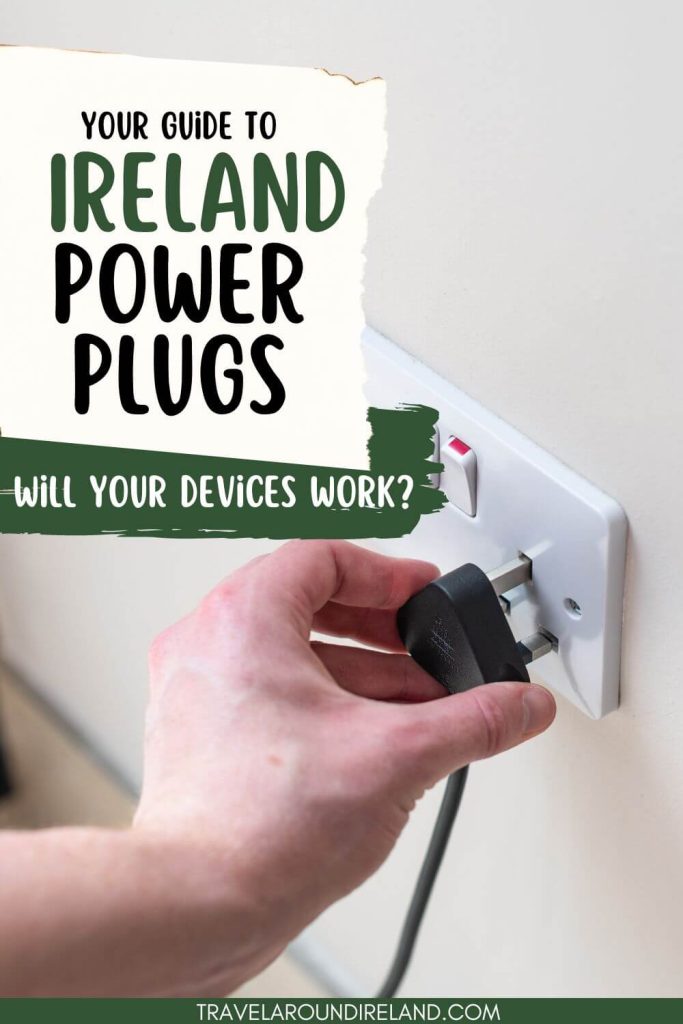If you plan to visit Ireland, you will undoubtedly want to bring some of your electronic devices. And as a result, you might be wondering how Ireland power plugs work.
Are they the same as where you are from? Will my devices charge in Dublin, Belfast or Galway?
Will I need an international converter to allow you to plug them into Irish sockets?
The answer to these questions generally depends on where your device comes from, though there are some exceptions to the rule.
In this article, you will learn whether your appliances will work in Ireland power sockets, and if not, what you can do about it.
*This post contains affiliate links, which may include Amazon affiliate links. To read more about affiliate links, please visit my Disclosure Policy page.
Devices in Ireland – Your Guide to Irish Power Plugs
Electrical Plugs and Outlets
Ireland uses Type G electrical outlets, that have three rectangular pins arranged in a triangle formation.

These sockets deliver 230 volts at 50 Hz, differing from many other countries. If you’re travelling from North America or parts of Asia, you’ll need both a voltage converter and a plug adapter to safely use your devices in Ireland.
While some modern electronics can automatically handle different voltages, it is crucial to check your devices’ specifications before plugging them in. Being prepared with the correct adapters will ensure you can keep your gadgets charged and ready for your Irish adventure.
In the diagram below, you can see the different types of plugs used around the world.

Type G plugs are unique to Ireland, the United Kingdom, and a few other countries.
The top pin of a Type G plug is the earth pin. It is slightly longer than the other two, which are the live and neutral pins. This design ensures proper grounding for electrical safety.
You will find Type G sockets in all Irish homes, businesses, and public spaces. They’re easily recognisable by their square shape and three rectangular holes.
It’s important to note that Type G plugs are not compatible with other European plug types. Always check your devices’ voltage compatibility before using them in Ireland to avoid damaging your equipment.
Will I Need an International Convertor in Ireland?
Bringing electronic devices to Ireland requires planning to ensure they function properly.
If your devices use anything other than the Type G power plug that we use in Ireland, then yes, you will need a conversion plug in order to get electricity to your hardware.
Selecting the Right Adapter
When packing for Ireland, choose adapters compatible with Type G sockets. These three-pronged outlets are standard throughout the country. Look for adapters labelled as ‘UK/Ireland’ or ‘Type G’ to ensure a proper fit.
It’s wise to purchase adapters before your trip, as they may be pricier or harder to find once you arrive. Consider buying multiple adapters if you plan to use several devices simultaneously.
Remember that an adapter only changes the plug shape, not the voltage. Most modern electronics can handle Ireland’s 230V system, but double-check your devices’ specifications to be certain.
Universal vs. Type-Specific Adapters
Universal adapters offer versatility for global travellers. They typically accommodate various plug types, including Ireland’s Type G. These all-in-one solutions are convenient if you are visiting multiple countries.
However, universal adapters can be bulkier and more expensive than type-specific options. They may also have a looser fit in sockets, potentially falling out more easily.
Type-specific adapters for Ireland are often more compact and secure. They’re ideal if you’re only visiting Ireland or the UK. These adapters usually provide a snug fit in Type G outlets, ensuring a reliable connection for your devices.
Consider your travel plans and device needs when choosing between universal and type-specific adapters. For frequent travellers, a combination of both might be the most practical solution.
Below is a world map with colour coding on the type of plug used for each country. Type G for Ireland is colour-coded orange.

My plug is sorted. Now what? Can I use my devices in Ireland?
It’s not as simple as finding a plug adapter. You also need to consider the electricity that your device has been made for. While some devices purchased outside of Ireland will work, some may not. And you need to check before you travel.
Ireland’s Electricity Rating
Across Ireland, the standard voltage is 230V, whilst the standard frequency is 50Hz. This is the same in homes, hotels, and even coffee shops.
For your appliance to work in Ireland it will need to have a similar voltage (or you will need to use a step-down transformer).

Will My 220 – 240 Volt Appliance Work in Ireland?
Devices from the majority of locations around the world will work. These countries/regions include the following (and will work without fault):
- Australia
- The United Kingdom
- Most of Africa
- The Middle East and most of Asia
- and many more.
To check your country, please use this detailed guide or view the map included below. If you are bringing an appliance from a country that’s marked either dark blue or light blue, you’ll be good to go in Ireland.
A 220V appliance is safe to use in a country like Ireland (with a voltage of 230v), as is a 240V. They are able to handle that level of variation.
Below is a world map with colour coding on the voltage and frequency used in each country. Check the voltage of the country where your device originated from versus that of Ireland before you travel.

Will My 120 Volt Appliance From the USA/Canada work in Ireland?
Any more significant variation (for example, 120V in the United States and Canada) is sometimes too great. Without a step-down transformer (or a device designed to work across electrical networks, as outlined in the following paragraph), you run the risk of blowing (and breaking) devices like hair dryers.
In short, a device purchased in the US or Canada may not work in Ireland, without a converter.
Will Some Devices Work Regardless of Where They’re From?
It is worth checking your appliance as some will work in Ireland regardless of where they were made.
If the label says ‘Input 100-240V, 50/60Hz’ then it is designed to work across all electrical systems throughout the world.
This is most often found on camera chargers, mobile phone chargers, electric toothbrush chargers and computer chargers; generally low-output devices.
Pro Tip: The fact that your device will work with the electrical system in Ireland will not negate your need for an appropriate adapter.
If you get to Ireland and require a travel adapter, here are some places to buy them locally:
- Curry’s
- DID Electrical
- Boots
- Power City
- Home Store and More
- Harvey Norman
And Finally – Tips for Safety and Compatibility
Using devices safely when travelling to Ireland requires careful consideration. Proper use of adapters and converters is essential to protect your electronics and ensure they function correctly.
Tips for Using Non-Irish Appliances
- When using non-Irish appliances in Ireland, always check the voltage and frequency compatibility as I have already mentioned. Irish sockets provide 230V at 50Hz. Use a voltage converter for devices that aren’t dual-voltage.
- Invest in high-quality adapters and converters from reputable brands. Cheap alternatives may pose safety risks. Never force a plug into an adapter; if it doesn’t fit easily, it is most likely incompatible.
- Be mindful of the power draw. Avoid using high-wattage appliances like hair dryers or straighteners with adapters alone. These often require voltage converters as well.
- Unplug adapters when not in use to prevent overheating. If you notice any unusual smells or sounds, disconnect your device immediately.
Remember, adapter plugs don’t change voltage. Always verify your device can handle Irish voltage before plugging it in.
Plan ahead of your trip to ensure you can use your electronics and devices as soon as you land on the Emerald Isle.
You might find these articles helpful:
- Travel Tips for Ireland
- Top 10 Things to Pack for Ireland
- Driving in Ireland as a Tourist
- Ways to Save Money in Ireland
Pin for later!


Travel Around Ireland is a participant in the Amazon Services LLC Associates Program, an affiliate advertising program designed to provide a means for sites to earn advertising fees by advertising and linking to amazon.com, amazon.co.uk, amazon.ca. Amazon and the Amazon logo are trademarks of Amazon.com, Inc. or its affiliates. To learn more about affiliate links, read my Disclosure Policy here.

Rather than buying a converter (which all seem to have negative reviews), would it be wiser to just purchase your hair dryers and curling irons at Boots?
It would but for those visiting Ireland from the US, they wouldn’t be guaranteed those appliances would work once they got home.